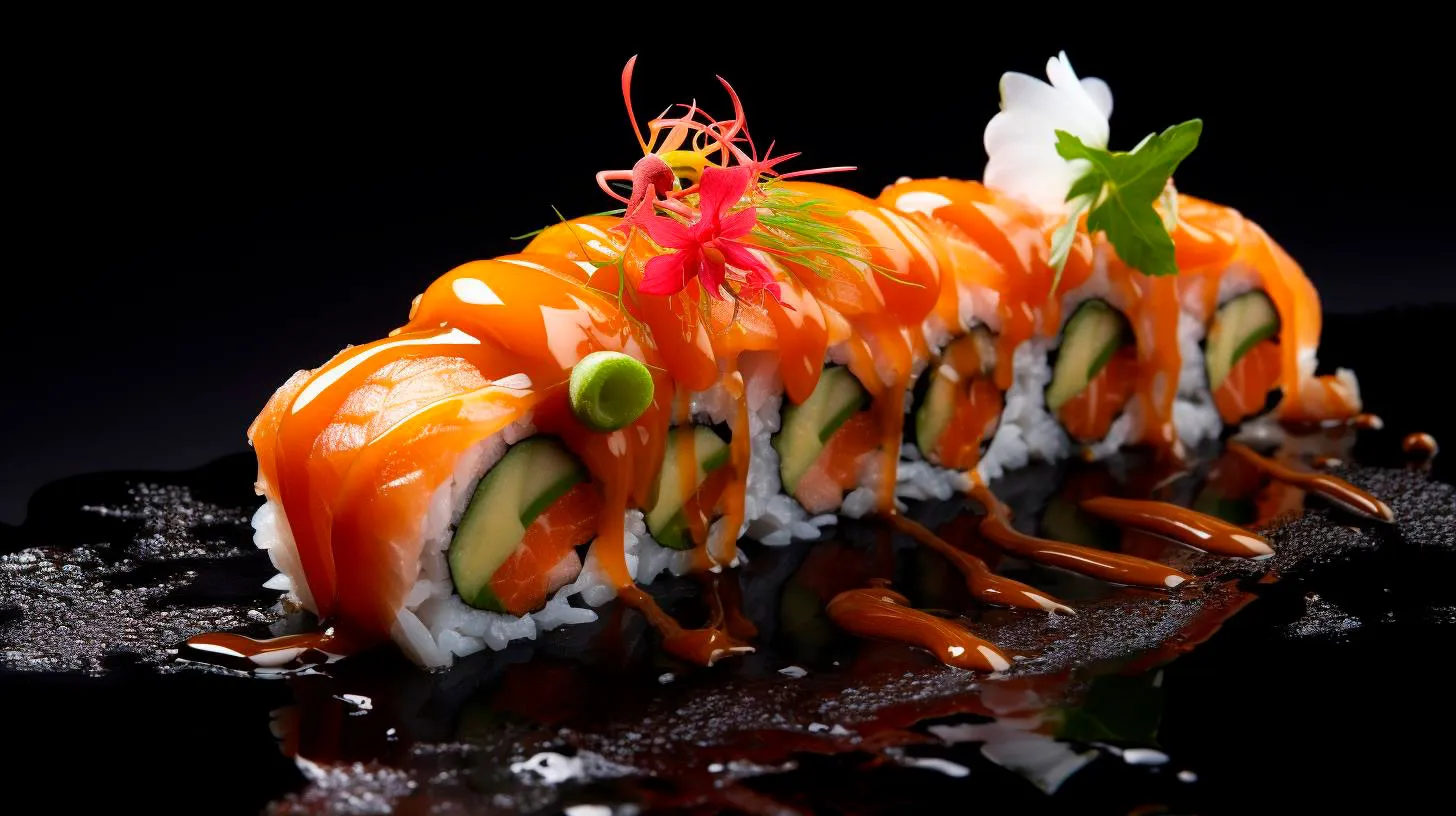Sushi: A Cultural Lens to Understand Social Classes in Japan
In this article, we will explore the evolution of sushi and delve into the ways it represents the social classes in Japanese society.
The Evolution of Sushi
Sushi, first developed in Southeast Asia as a preservation method for fish, made its way to Japan around the 8th century. Initially, it was consumed only by the upper classes due to the expensive ingredients and elaborate preparation involved.
Over time, sushi transformed from a preservation technique to an art form. In the Edo period, from the 17th to the 19th century, sushi gained popularity amongst the working-class population. Street food stalls known as yatai served sushi to the commoners, revolutionizing its accessibility. This democratization of sushi played a crucial role in shaping its association with social classes in Japan.
Sushi and the Social Classes
1. Traditional Luxury: Omakase
Omakase, meaning “I leave it up to you,” is the epitome of fine dining in sushi. This style encompasses the pinnacle of culinary artistry, where the chef carefully selects each piece of fish and prepares it with precision. Omakase experiences are often reserved for the upper echelons of society, providing a platform for the wealthy to showcase their status.
- Features: Exquisite presentation, personalized service, rare and premium ingredients.
- Advantages: Unforgettable gastronomic experience, opportunity to taste exclusive, hard-to-find ingredients.
- Key Takeaway: Omakase showcases the opulence and exclusivity associated with higher social classes in Japan.
2. Quick and Convenient: Conveyor Belt Sushi
Conveyor belt sushi, also known as kaiten sushi, revolutionized the way sushi was consumed. This method involves small plates of sushi placed on a revolving conveyor belt, allowing customers to pick and choose what they want. The affordability and speed of conveyor belt sushi made it popular amongst the middle class, offering a convenient and affordable dining experience.
- Features: Affordable prices, quick and self-service, diverse selection of sushi.
- Advantages: Cost-effective dining option, opportunity to try a wide variety of sushi, quick service for busy individuals.
- Key Takeaway: Conveyor belt sushi embodies the versatility and accessibility associated with the middle class in Japan.
3. Economic and Healthy: Sushi in Supermarkets
Another reflection of social classes in Japan can be observed through the availability of sushi in supermarkets. Supermarkets provide pre-packaged sushi at lower prices, making it appealing to the working-class population. This affordable option allows individuals from various socioeconomic backgrounds to enjoy sushi regularly.
- Features: Pre-packaged sushi, economical choice, wide availability in supermarkets.
- Advantages: Budget-friendly option, availability in remote areas, easy access to fresh and healthy food.
- Key Takeaway: Sushi in supermarkets represents the accessibility and affordability associated with the working class in Japan.
The Significance of Sushi
Beyond its culinary appeal, sushi serves as a cultural lens through which we can better understand the social fabric of Japan. Its evolution from an elite delicacy to a popular street food reflects the continuous transformation and adaptation of social classes throughout the country’s history.
By examining the different styles and contexts in which sushi is consumed, we gain insights into the changing dynamics of Japanese society. Whether indulging in an opulent omakase experience or enjoying a quick conveyor belt sushi meal, sushi remains a representation of social class and cultural tradition.
In conclusion, sushi offers us a fascinating perspective on the social classes in Japan. From its humble origins to its present-day variations, sushi symbolizes the diversity and complexity of Japanese society. Whether you’re dining in a high-end sushi restaurant or grabbing a convenient plate from a conveyor belt, the flavors and cultural significance of sushi will continue to unite people from all walks of life.
Social Hierarchies in Japanese Literature
This blog article will delve into the fascinating topic of social hierarchies in Japanese literature, discussing their significance, portrayal, and their enduring relevance in contemporary society.
The Importance of Social Hierarchies in Japanese Society
In Japanese culture, social hierarchies have long played a crucial role in shaping relationships and interactions. These hierarchies are deeply rooted in traditional Confucian values, which emphasize respect for authority, obedience, and a clear understanding of one’s place within the social order. This hierarchical structure can be seen in various aspects of Japanese society, including family relationships, work dynamics, and even language.
When it comes to Japanese literature, authors often use the portrayal of social hierarchies to highlight the complexities and challenges faced by individuals in their interactions with others. These hierarchies provide a framework for understanding the characters’ positions within society and the constraints they face due to societal expectations.
The Role of Social Hierarchies in Japanese Literature
Japanese literature frequently explores the impact of social hierarchies on individuals’ lives. Here are some key aspects regarding their portrayal:
- Power Dynamics: Social hierarchies in Japanese literature often depict power imbalances between different social classes. Whether it is the samurai class in feudal Japan or the disparities between rich and poor in modern settings, authors use these power dynamics to delve into the characters’ struggles, ambitions, and sacrifices.
- Gender Roles: Literature from Japan frequently addresses the traditional gender roles imposed by social hierarchies. These works explore the challenges faced by women and the constraints placed on them, while also showcasing the resilience and agency of female characters.
- Social Expectations: Social hierarchies in Japanese literature reflect the societal expectations placed on individuals. Authors delve into the internal conflicts characters experience as they grapple with the pressure to conform or rebel against these expectations.
Relevance in Contemporary Japanese Society
Although Japanese society has evolved over the years, social hierarchies continue to be relevant in contemporary settings. Here are some key takeaways regarding their enduring significance:
- Workplace Dynamics: In modern Japan, social hierarchies are still prominent in the workplace, where respect for seniority and clear lines of authority are deeply ingrained. Understanding these dynamics is crucial for successful professional relationships and career advancement.
- Family Relationships and Filial Piety: Japanese literature often explores familial hierarchies and the importance of filial piety. These themes resonate with societal expectations regarding respect for elders and familial duty, which remain important aspects of Japanese family life today.
- Social Etiquette: Proper manners and adherence to social protocols continue to be highly valued in Japanese society. Understanding the nuances of social hierarchies helps navigate these etiquette customs and build meaningful connections.
Conclusion
Social hierarchies play a significant role in Japanese literature, allowing authors to delve into power dynamics, gender roles, and societal expectations. By exploring these themes, literature serves as a mirror to Japanese society, past and present. Understanding social hierarchies is not only essential for a deeper appreciation of Japanese literature but also for navigating the complexities of contemporary Japanese social interactions.
The Symbolism of Sushi in Japanese Literary Works
Sushi, a traditional Japanese dish, has become a symbol of Japan’s rich cultural heritage. It not only represents the country’s culinary expertise but also carries deep symbolism in literary works. In this article, we will explore the symbolic significance of sushi in Japanese literature.
Connection to Nature
Japanese literature often uses symbolism to highlight the connection between humans and nature. Sushi, with its use of fresh and seasonal ingredients, serves as a perfect metaphor for this connection. Just as nature provides the raw materials for sushi, it also inspires and sustains the characters in Japanese literary works.
Key Takeaways:
- Sushi highlights the harmony between humans and nature in Japanese literature.
- The use of fresh and seasonal ingredients represents the connection to nature.
- Sushi serves as a metaphor for inspiration and sustenance from nature.
Social Hierarchy and Status
In Japanese society, sushi has long been associated with social hierarchy and status. Historically, sushi was reserved for the upper class and aristocracy. This notion of exclusivity and privilege often finds its way into Japanese literature. The presence or absence of sushi in a literary work can signify the characters’ social standing or the divide between different classes.
Key Takeaways:
- Sushi represents social hierarchy in Japanese literature.
- Its historical association with the upper class symbolizes exclusivity and privilege.
- The presence or absence of sushi reflects characters’ social standing.
Attention to Detail and Craftsmanship
The art of sushi making requires immense precision, attention to detail, and craftsmanship. Every slice of fish, every grain of rice, and every brush of soy sauce must be meticulously arranged. This pursuit of perfection is mirrored in Japanese literary works. Authors often use sushi as a metaphor to emphasize the importance of attention to detail and the pursuit of excellence.
Key Takeaways:
- Sushi making epitomizes precision, attention to detail, and craftsmanship.
- Sushi serves as a metaphor for the pursuit of perfection in Japanese literature.
- Authors highlight the importance of attention to detail through sushi references.
Delicacy and Sensuality
Sushi, with its delicate flavors and textures, tantalizes the senses. The act of eating sushi becomes an experience that engages all the senses. In Japanese literary works, authors often use sushi to evoke sensuality and explore themes of desire. The consumption of sushi can symbolize the indulgence and sensual pleasures that characters in these works seek.
Key Takeaways:
- Sushi stimulates the senses and represents sensory indulgence.
- Authors use sushi to explore themes of desire and sensuality.
- The act of eating sushi becomes an experience of sensory pleasure in literature.
Conclusion
Sushi, with its deep cultural significance and symbolism, has found its way into the heart of Japanese literature. It represents the connection to nature, social hierarchy, attention to detail, and indulgence in sensuality. By incorporating sushi into their works, Japanese authors create multi-layered narratives that capture both the literary and cultural essence of Japan.
Explore the symbolism of sushi in Japanese literature and discover a rich tapestry of cultural references that will transport you to the heart of ancient Japan.
Social Stratification Portrayed Through Sushi in Japanese Literature
The Symbolism of Sushi
In Japanese literature, sushi often serves as a powerful metaphor for social stratification. It represents more than just a culinary delight; sushi embodies the stark divisions and hierarchies that exist within Japanese society. By highlighting the symbolism behind sushi, writers cleverly unravel the complexities of social class and its impact on individuals.
Sushi as a Reflection of Social Classes
1. Nigiri Sushi: Nigiri sushi, with its simple yet elegant presentation, embodies the upper class. Its use of high-quality ingredients and precise craftsmanship make it a symbol of refinement and wealth. This type of sushi is often portrayed in Japanese literature as being favored by aristocrats and influential figures.
2. Maki Rolls: Maki rolls, on the other hand, are more accessible and affordable. They represent the middle class and are commonly enjoyed by the general population. Maki rolls symbolize the working class and their ability to indulge in the pleasures of sushi while still being conscious of cost.
Portrayal of Social Classes in Japanese Literature
Japanese literature often showcases the interactions between characters from different social classes, using sushi as a catalyst for exploring their relationships and struggles. These narratives provide valuable insights into the societal dynamics that are prevalent in Japan.
Social Divide and Its Impact
1. Restrictive Etiquette: In Japanese literature, the strict etiquette surrounding sushi consumption emphasizes the separation between social classes. Upper-class characters are shown adhering to traditional rules and practices, while lower-class characters may struggle to conform.
2. Exclusion and Judgement: Sushi can become a tool for perpetuating discrimination and exclusion. Literature often illustrates instances where individuals from lower classes are judged or excluded based on their unfamiliarity with sushi etiquette, highlighting the harsh realities of social stratification.
Key Takeaways
Sushi serves as a poignant symbol in Japanese literature, reflecting the social stratification that exists within Japanese society. By weaving intricate narratives around sushi, writers shed light on the divisions and hierarchies that shape individuals’ experiences. Key takeaways from this exploration include:
- Sushi serves as a metaphor for social classes within Japanese literature.
- Nigiri sushi symbolizes the upper class, while maki rolls represent the middle class.
- Social etiquettes surrounding sushi consumption highlight the social divide and its impact on characters.
- Sushi can be used to perpetuate discrimination and exclusion based on social standing.
Ultimately, the portrayal of social stratification through sushi in Japanese literature showcases the intricacies and tensions that exist within society. By delving into these narratives, readers can gain a deeper understanding of the cultural and social dynamics of Japan.



